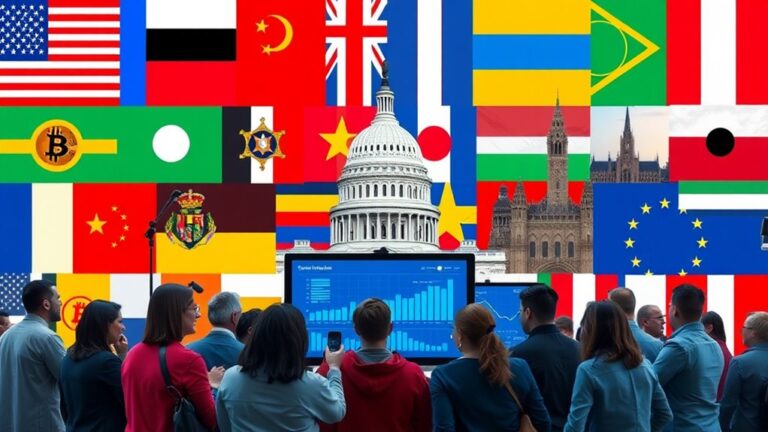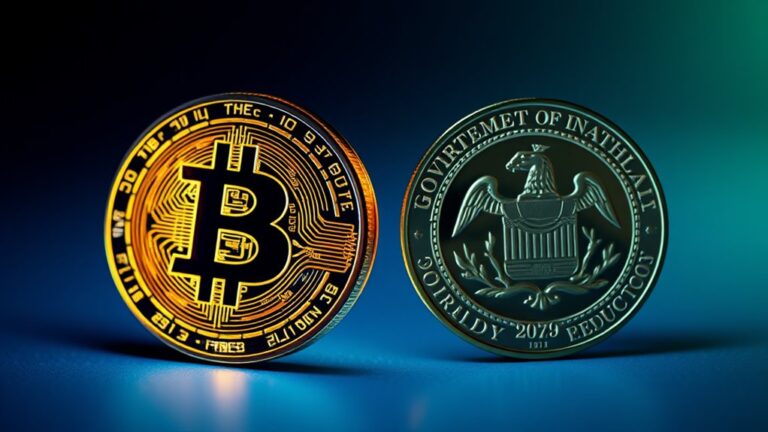
Crypto Regulations and DeFi Challenges: Navigating the Shifting Landscape
The cryptocurrency regulatory landscape is shifting rapidly worldwide. The EU’s MiCAR implementation brings bank-like rules to digital assets, while the US adopts a more innovation-friendly approach under Trump. DeFi faces significant security challenges, with smart contract vulnerabilities causing billions in losses. Countries with clear regulations attract more institutional investment, while regulatory uncertainty creates market volatility. Balancing innovation with compliance remains difficult as international bodies work toward standardized frameworks. Further exploration reveals how these dynamics impact market participants across the global ecosystem.
Key Takeaways
- MiCAR implementation in December 2024 extends bank-like regulations to cryptocurrency markets, signaling global regulatory tightening.
- DeFi protocols face severe security vulnerabilities, with $2.6 billion in damages from attacks in 2022, particularly affecting cross-chain bridges.
- Clear regulatory frameworks correlate with increased institutional investment, market stability, and confidence in cryptocurrency markets.
- Decentralized structure of DeFi creates unique challenges for implementing KYC/AML requirements without compromising innovation.
- International standardization efforts led by the Financial Stability Board aim to minimize regulatory arbitrage while ensuring market safety.
The Global Regulatory Landscape: From MiCAR to Trump’s Executive Order

As global cryptocurrency markets continue to expand, regulatory frameworks have emerged across different jurisdictions to address the unique challenges posed by digital assets.
The EU’s MiCAR implementation, effective December 30, 2024, extends bank-like rules to stablecoins and cryptocurrencies, requiring strict capital and risk management practices similar to traditional financial institutions.
In contrast, the US regulatory approach has shifted with President Trump’s executive order, which promotes digital asset innovation while prohibiting CBDCs.
The order establishes a Working Group on Digital Assets and supports blockchain technology and self-custody rights.
These divergent approaches highlight the transatlantic alignment challenges in cryptocurrency regulation, despite international bodies like the Financial Stability Board pushing for standardized regulations across G20 jurisdictions to address jurisdictional enforcement complications. Additionally, global trends reveal an increased emphasis on anti-money laundering measures to protect consumers and ensure financial integrity.
DeFi’s Security and Financial Stability Concerns

While the decentralized finance (DeFi) sector has revolutionized traditional financial systems, it continues to face significant security and financial stability challenges that threaten its mainstream adoption.
Technical vulnerabilities in smart contracts led to staggering losses, with DeFi protocols accounting for 82.1% of stolen cryptocurrency funds in 2022, totaling $3.1 billion.
Smart contract flaws devastated DeFi security, responsible for over $3 billion in crypto theft during 2022.
The DeFi Protocols layer remains the most targeted, representing 54.46% of attacks and $2.6 billion in damages. Cross-chain bridges are particularly vulnerable, accounting for 64% of stolen funds.
Market volatility and liquidity mismatches further compound financial stability concerns.
Regulatory challenges stem from DeFi’s decentralized nature, which complicates AML/KYC compliance and jurisdictional oversight. Additionally, the lack of effective KYC procedures in many DeFi platforms increases the risk of fraud and illegal activities within the ecosystem.
Mitigation strategies include regular smart contract audits, multiple wallet usage, and engaging with established protocols that prioritize security.
Economic Impact of Shifting Crypto Regulations

The economic landscape surrounding cryptocurrencies continues to evolve dramatically in response to changing regulatory frameworks worldwide. Countries implementing clear, supportive regulations typically experience increased institutional investment and market stability, while those imposing restrictions often see market contractions and capital flight.
Recent SEC approvals of Ethereum ETFs demonstrate how positive regulatory actions can boost market confidence and attract institutional participation. Conversely, regulatory uncertainty creates volatility that discourages investment and hampers market growth. This impact is particularly pronounced in emerging markets, where cryptocurrencies may challenge monetary policy effectiveness and increase fiscal risks.
As global bodies like the IMF work toward establishing thorough frameworks, businesses must adapt to remain competitive. The balance between innovation and protection ultimately determines whether a jurisdiction benefits from or misses the economic opportunities presented by digital assets. Additionally, understanding and implementing anti-money laundering (AML) practices can significantly enhance a business’s compliance posture in this shifting landscape.
Innovation vs. Compliance: The Delicate Balance

Steering through the intersection of innovation and compliance represents one of the most significant challenges facing cryptocurrency and DeFi projects today.
The fragmented regulatory environment, with multiple agencies creating overlapping rules, complicates adherence while technological advancements outpace existing standards.
Successful projects implement strict KYC and AML protocols while acquiring necessary licenses.
Many leverage blockchain’s inherent transparency and RegTech solutions to manage compliance more efficiently.
Smart contracts, when properly designed, can incorporate regulatory requirements from the outset, reducing later adjustments.
The global variance in regulations—from supportive frameworks in Singapore to outright bans in China—further complicates this balance.
Companies increasingly adopt zero-knowledge proofs and adaptable business models to maintain compliance without sacrificing the innovative potential that makes blockchain technology revolutionary. Recent developments indicate a shift towards a more balanced approach in the U.S., with efforts to establish clearer regulations that foster innovation while ensuring compliance with anti-money laundering standards.
The Path Forward: Standardization and International Cooperation

Harmonization of regulatory frameworks across borders represents the most promising avenue for addressing the complex challenges facing the cryptocurrency ecosystem.
The Financial Stability Board (FSB) has emerged as a critical coordinator, proposing nine high-level recommendations to establish consistent global standards for cryptoasset activities, with additional guidance for stablecoins.
International bodies like the Basel Committee on Banking Supervision and the Financial Action Task Force have extended existing frameworks to address crypto-specific risks.
However, significant obstacles remain, including jurisdictional ambiguity in decentralized ledger technologies, data reliability issues, and the rapid pace of innovation.
The IMF, working alongside the FSB, continues to develop thorough regulatory strategies that balance innovation with stability and consumer protection. Recent developments in the U.S., including President Trump’s executive order, highlight the shifting regulatory landscape and its potential impact on global cooperation.
This collaborative approach aims to minimize regulatory arbitrage while ensuring cryptoasset markets can function safely across global boundaries.
Frequently Asked Questions
How Do Crypto Regulations Affect Individual Tax Reporting Requirements?
Crypto regulations require individuals to report all taxable events, including trades, mining, and staking income. New broker reporting rules in 2025 will automate transaction tracking, while penalties exist for non-compliance with IRS requirements.
Can Defi Protocols Be Made Compatible With Existing Aml/Kyc Frameworks?
MetaMask’s integration with identity verification tools exemplifies how DeFi protocols can adapt. While complete compatibility faces significant challenges, hybrid solutions leveraging wallet scoring, blockchain analytics, and zero-knowledge proofs offer promising paths toward regulatory compliance without sacrificing decentralization.
What Insurance Options Exist for Defi Users Against Hacks?
DeFi users can access insurance through platforms like Nexus Mutual, InsurAce, and Unslashed that offer coverage against smart contract failures, hacks, and exploits. These policies operate via decentralized risk-sharing pools managed by community governance.
How Will Quantum Computing Impact Crypto Regulatory Frameworks?
“Where there’s smoke, there’s fire.” Quantum computing will likely trigger regulatory overhauls requiring quantum-resistant encryption standards, stricter disclosure requirements, enhanced governance frameworks, and international coordination to address cross-border cryptocurrency security challenges.
Which Career Skills Are Most Valuable in Crypto Compliance?
Regulatory expertise, blockchain technical understanding, and risk assessment capabilities are most valuable in crypto compliance. Strong analytical skills and adaptability to rapidly changing frameworks also prove essential for professionals in this specialized field.
Conclusion
As regulators and innovators navigate these uncharted waters, the crypto industry stands at a crossroads. Like a ship adjusting its sails to changing winds, the DeFi ecosystem must adapt to evolving regulations while preserving its innovative essence. Through international cooperation and balanced oversight, a framework can emerge that protects consumers, guarantees financial stability, and allows blockchain technology to fulfill its transformative potential in the global economy.












